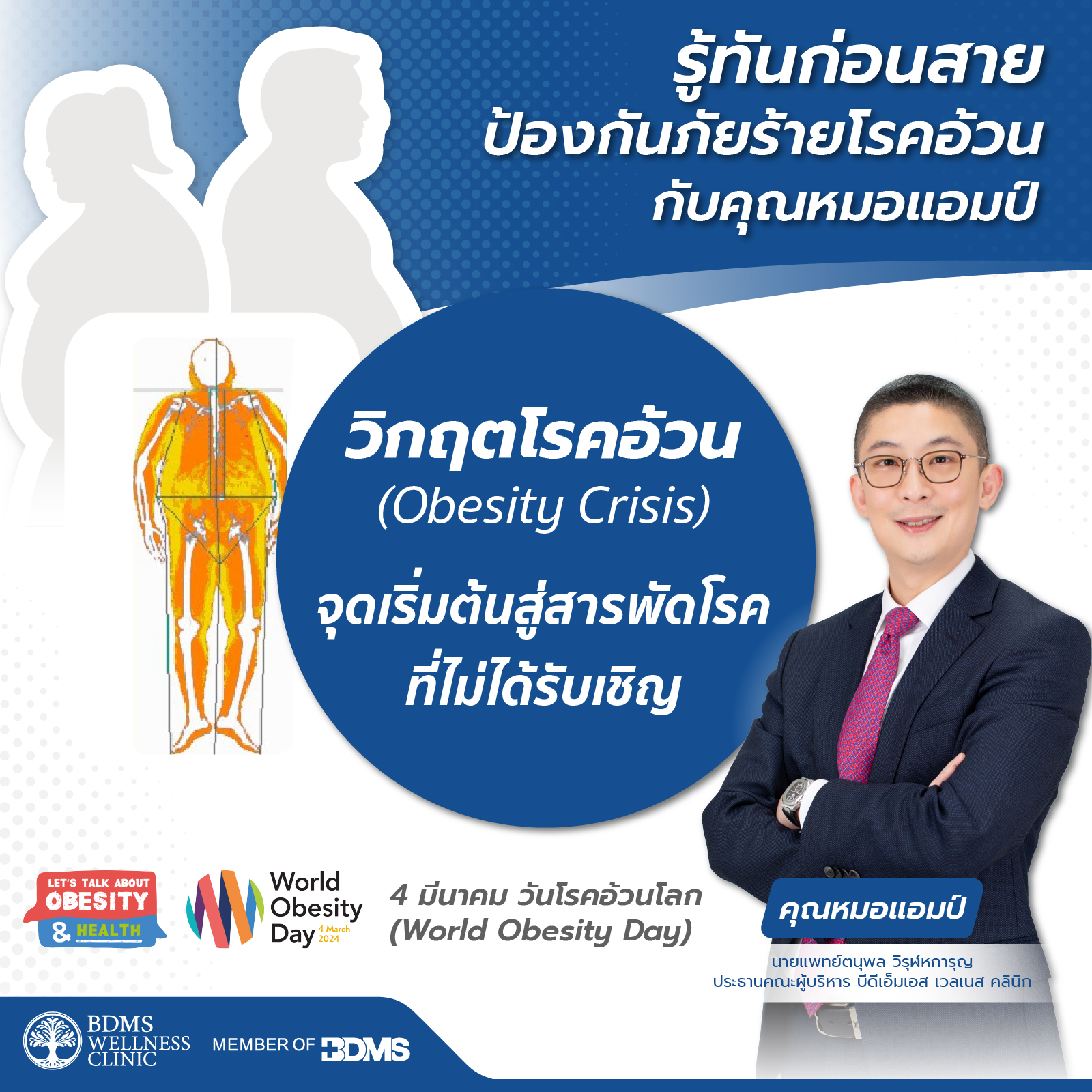Stay Ahead and Prevent the Obesity Crisis with Dr. Amp
Obesity is one of the non-communicable diseases (NCDs) like type 2 diabetes, high blood pressure, or cancer. Obesity is a threat that people worldwide must fight together. Because not only does it have a direct negative effect on physical health, but it also has an indirect negative effect on the economy and society.
According to the World Health Organization (WHO), obesity is a condition where the body has an excessive accumulation of fat, leading to various abnormalities in the body's systems, such as Obstructive Sleep Apnea (OSA), joint problems, weakened immune system, metabolic disorders, high sugar and fat levels, increased inflammation in the body, and increased risk of type 2 diabetes, cardiovascular diseases (CVDs), and cancer, etc.
Dr.Amp - Tanupol Virunhagarun, M.D., President of Bangkok Association of Regenerative Health and The Study of Obesity (BARSO) and Chief Executive Officer of BDMS Wellness Clinic, is determined to raise awareness about the issue of obesity on "World Obesity Day," which falls on March 4th. The aim is to campaign for society to become aware of the dangers of obesity and to stop the increasing obesity crisis.

The Obesity Crisis
Data from the World Obesity Federation in 2020 revealed that approximately 1 billion people, or roughly 1 in 7 individuals, are grappling with the issue of obesity. This aligns with the World Health Statistics 2023 report from the World Health Organization (WHO), which indicates that out of 1.9 billion adults globally, 39% are dealing with overweight and obesity. In Thailand, data from the Ministry of Public Health in 2023 indicated that 48.35% of Thais are struggling with overweight and obesity.
Another crucial demographic not to be overlooked is children, as their health during childhood significantly influences their health status and quality of life as adults. A study published in the Frontiers in Nutrition journal in 2023 projected that obese children and adolescents are up to 5 times more likely to become obese adults compared to non-obese counterparts. Additionally, 55% of overweight adolescents are expected to develop obesity, and obese adolescents have an 80% likelihood of becoming obese adults and a 70% likelihood of developing obesity-related diseases by the age of 30. The number of children with overweight and obesity has significantly increased, with WHO showing a rise from 4% in 2018 to 18% or more than 340 million individuals aged 5-19 in 2022.
For Thailand, data from the Health Data Center (HDC) of the Ministry of Public Health revealed alarming rates of overweight and obesity in children. In 2023, the prevalence of overweight and obesity among children under 5 years old was 8.98%, while it was 13.68% among children aged 6-14 and 13.72% among those aged 15-18.
The Seriousness of Obesity
Dr. Amp explains that obesity, like other diseases, has various stages, starting from being asymptomatic to severe complications. Therefore, prevention of obesity is better than allowing it to progress until illness occurs.
The American Association of Clinical Endocrinologists (AACE) has classified obesity into three main stages:
- Stage 0 Presence of adipose tissue (body fat) without any complications.
- Stage 1 Presence of minor to moderate complications associated with obesity, with at least one symptom.
- Stage 2 Presence of severe complications associated with obesity, with at least one symptom.
Obesity-related problems negatively impact both physical and mental health, both in the short and long term. The severity of these impacts depends on the severity of obesity, including:
- Metabolic consequences
Abnormalities affecting waist circumference, high blood pressure, high levels of sugar and fat in the blood, insulin resistance, and increased inflammation in the body, leading to various non-communicable diseases (NCDs) such as chronic kidney disease, type 2 diabetes, stroke, atherosclerotic cardiovascular disease (ASCVD), and cancer.
- Gastrointestinal Problems
Obesity is a primary cause of gastroesophageal reflux disease (GERD), increased risk of gallstones, gallbladder inflammation, and non-alcoholic fatty liver disease (NAFLD), which are risk factors for future liver cirrhosis and liver cancer.
- Respiratory Complications
Excessive weight can reduce lung capacity, leading to sleep-related breathing disorders like obstructive sleep apnea (OSA), resulting in poor sleep quality, daytime fatigue, decreased work performance, increased risk of accidents, and road traffic accidents.
- Orthopedic Issues
Excess weight often causes bone and muscle pain, such as in the spine, hips, knees, and feet, leading to reduced mobility, difficulty walking, and, in the long term, knee osteoarthritis.
- Psychological Impact
Obesity affects mental health by increasing the risk of depression, social withdrawal, reduced interpersonal relationships, decreased self-esteem, fatigue, and reduced quality of life due to weight stigma. It may also lead to anxiety, stress, and negative behaviors such as binge eating disorder, impulsivity, and difficulty controlling emotions.
Indicators of Obesity: Body Fat Mass
To understand the definition of obesity, Dr. Amp explains that it was originally assessed using the Body Mass Index (BMI), where individuals with a BMI of 25 kg/m² or higher were considered overweight, and those with a BMI of 30 kg/m² or higher were considered obese. However, BMI may not be the most accurate tool for assessing obesity because it does not consider body composition. For example, individuals with the same BMI may have different proportions of muscle and fat, such as athletes having more muscle than sedentary individuals. Therefore, relying solely on BMI for diagnosis is not recommended.
Dr. Amp recommends using other tools such as measuring waist circumference, as it can indicate accumulated visceral fat, which is associated with metabolic syndrome. In Asian adult males, the waist circumference should not exceed 90 cm (36 inches), and in Asian adult females, it should not exceed 80 cm (32 inches).
However, the best method, according to Dr. Amp, is to measure body composition using Dual-Energy X-ray Absorptiometry (DEXA) to accurately assess total body fat percentage. In middle-aged adults (aged 20–50 years), females should not have more than 32% body fat, and males should not exceed 28%.
Causes of Obesity
People often think that obesity is solely caused by overeating and lack of physical activity. However, obesity actually results from various factors, including poor sleep, hormonal imbalances, certain medications, and genetic predisposition.
- Hormonal Causes
One cause of obesity is an imbalance in appetite and satiety control regulated by the neuroendocrine system. Leptin, a hormone produced by fat cells, signals the brain to feel full. Inadequate sleep can reduce leptin levels, leading to increased appetite. Leptin resistance, where the body does not respond to leptin signals, is common in obese individuals, causing them to feel less full and eat more.
Ghrelin, on the other hand, is a hormone that stimulates hunger and is released before meals. In obese individuals, ghrelin levels may remain elevated even after eating, leading to persistent feelings of hunger.
- Genetic Causes
Obesity often runs in families, suggesting a genetic component. Genes such as MC4R, POMC, and FTO are associated with obesity. However, genetics is not the sole cause of obesity; lifestyle factors play a crucial role, such as eating patterns within the family, portion sizes, and the types of foods consumed.
Epigenetic Processes
Epigenetics studies gene expression influenced by lifestyle factors rather than changes in the genetic code itself. For example, a high-fat diet can reduce the activity of PPARγ, a gene involved in cell metabolism. Exercise increases the expression of PGC1α, which controls energy metabolism, while inadequate rest reduces the activity of genes such as Cry1 and BMAL1, which regulate cortisol levels, appetite, and blood sugar. Additionally, epigenetic changes affect SCD1, a gene involved in fat synthesis and breakdown.
It can be seen that lifestyle behaviors such as poor diet, inadequate sleep, and lack of exercise are also important factors contributing to overweight and obesity. To prevent weight gain, Dr. Amp recommends simple health care guidelines to keep obesity at bay. Here are 7 easy steps:
- Choose nutritious foods: In one plate, consume 50% vegetables, another 25% high-quality protein such as fish, tofu, beans, and legumes, and the remaining 25% should be unrefined carbohydrates like brown rice.
- Avoid high-fat foods, especially trans fats and saturated fats, such as fatty meats, animal skins, offal, cakes, fast foods, bubble tea, processed meats like bacon, sausages, ham, luncheon meat, canned fish, pork belly, pork rinds, and meatballs.
- Avoid foods and drinks high in sugar, especially those containing High Fructose Corn Syrup (HFCS), such as sweetened beverages, soft drinks, syrup, fruit juice, jam, candies, cookies, ice cream, cakes, and pies.
- Exercise regularly for at least 150 minutes per week or at least 30 minutes, 5 days a week.
- Get adequate restful sleep, at least 8-9 hours every night, and try to go to bed before 10 PM to allow the body to release hormones normally.
- Avoid alcohol and smoking.
- Manage stress by practicing meditation, walking in nature, or engaging in activities that calm the mind.
Obesity is a complex issue caused by various factors, so it requires cooperation from all sectors, including families, educational institutions, and government and private sectors, to change the lifestyles and environments of Thai people to prevent obesity.
On the occasion of World Obesity Day 2024 under the theme 'Let's Talk About Obesity And.....', which leaves space for everyone to choose important issues related to obesity prevention campaigns, the doctor joins in raising awareness of the dangers of obesity.
"This goes beyond personal health; it's an investment in our community. Let's take action against obesity today, shaping a future where our children thrive in a healthier society together." - Dr. Amp
Reference
- WHO. Obesity and Overweight [Internet]. Geneva: World Health Organization; 2021. Available from: https://www.who.int/news-room/fact-sheets/detail/obesity-and-overweight
- WHO. World health statistics 2023: monitoring health for the SDGs, Sustainable Development Goals. Geneva: World Health Organization; 2023. Licence: CC BY-NC-SA 3.0 IGO.
- ระบบคลังข้อมูลด้านการแพทย์และสุขภาพ (Health Data Center : HDC) [Internet]. กระทรวงสาธารณสุข; 2566 [เข้าถึงเมื่อ 11 มกราคม 2567]. เข้าถึงได้จาก: https://hdcservice.moph.go.th/hdc/reports/page.php?cat_id=46522b5bd1e06d24a5bd81917257a93c
- Bays HE, Golden A, Tondt J. Thirty Obesity Myths, Misunderstandings, and/or Oversimplifications: An Obesity Medicine Association (OMA) Clinical Practice Statement (CPS) 2022. Obesity Pillars. 2022 Sep;3:100034.
- Garvey WT, Mechanick JI, Brett EM, Garber AJ, Hurley DL, Jastreboff AM, et al. American Association of Clinical Endocrinologists and American College of Endocrinology Comprehensive Clinical Practice Guidelines For Medical Care of Patients with Obesity. Endocrine Practice. 2016;22:1-203.
- Beck B. Neuropeptide Y in normal eating and in genetic and dietary-induced obesity. Philosophical Transactions of the Royal Society B: Biological Sciences. 2006;361(1471):1159-85.
- Sinha R. Role of addiction and stress neurobiology on food intake and obesity. Biological psychology. 2018;131:5-13.
- Beccuti G, Pannain S. Sleep and obesity. Current Opinion in Clinical Nutrition and Metabolic Care. 2011;14(4):402.
- Contreras RE, Schriever SC, Pfluger PT. Physiological and Epigenetic Features of Yoyo Dieting and Weight Control. Front Genet. 2019;10:1015-.
- World Obesity Federation. LET'S TALK ABOUT OBESITY AND... YOUTH [Internet]; 2024 Jan 25 [cited 2024 Jan 26]. Available from: https://www.worldobesityday.org/youth
- World Obesity Federation. Key stats: LET'S TALK ABOUT OBESITY AND... [Internet]. London; 2024 [cited 2024 Jan 26]. Available from: https://new.express.adobe.com/webpage/gc8fPr6ZVWw27
- Mahmoud AM. An Overview of Epigenetics in Obesity: The Role of Lifestyle and Therapeutic Interventions. Int J Mol Sci. 2022;23(3):1341.
- Gülü M, Yagin FH, Yapici H, et al. Is early or late biological maturation trigger obesity? A machine learning modeling research in Turkey boys and girls. Front Nutr. 2023;10:1139179.




